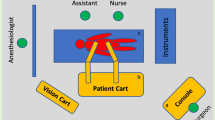Abstract
Despite improved technology for endovascular treatment of aorto iliac occlusive disease, aortobifemoral bypass (ABF) continues to offer superior long-term patency. In an effort to reduce the morbidity of surgical ABF, multiple minimally invasive techniques have been reported. The da Vinci robot may facilitate the construction of a minimally invasive aortic anastomosis using standard vascular suture techniques. Our initial experience in the development of a minimally invasive surgical aortic reconstruction program is reported. After extensive time in the laboratory developing our surgical technique in human cadavers and a pig model, our team initiated a robotic vascular surgery program in 2007. A retrospective review of our initial six robot-assisted laparoscopic ABF cases was conducted. The aorta was exposed laparoscopically using the Stadler technique and the aortic anastomosis performed with the da Vinci robot. These results are compared with currently published reports of robotic ABF and alternative methods of minimally invasive aortic reconstruction. From January 2007 to August 2007, six robot-assisted laparoscopic ABFs were performed. Two patients had prior abdominal surgical procedures. Four patients had prior endovascular or surgical aorto iliac reconstruction. Operative time varied from 5 h 26 min to 8 h 12 min. Total clamp time, for the aortic anastomosis, ranged from 70 to 100 min with a mean of 75 min. Estimated blood loss ranged from 300 to 2,000 ml with a mean of 850 ml. Conversion with a short upper midline incision was required in one patient (16%) with an associated abdominal aortic aneurysm. Post operative length of stay ranged from five to ten days with a median of seven days. There was no operative mortality. Results from robotically assisted laparoscopic ABF are equivalent to those from other minimally invasive options while enabling a much shorter learning curve. Using the technique described, minimally invasive ABF was accomplished in a safe and reliable manner despite prior vascular treatment.




Similar content being viewed by others
References
Rutherford RB (2005) Results of direct aortoiliobifemoral reconstruction. In: Rutherford RB (ed) Vascular surgery, 6th edn. Saunders/Elsevier, Amsterdam, p 1124
Nio D, Diks J, Bemelman WA, Wisselink W, Legemate DA (2007) Laparoscopic vascular surgery: a systematic review. Eur J Vasc Endovasc Surg 33:263–271
Stadler P, Vitasek P, Spacek M (2006) Robot-assisted aortoiliac reconstruction: a review of 30 cases. J Vasc Surg 44(5):915–919
Dion YM, Kathouda N, Rouleau C, Aucoin A (1993) Laparoscopy-assisted aortobifemoral bypass. Surg Laparosc Endosc 3:425–429
Norgren L, Hiatt WR, Dormandy JA, Nehler MR, Harris KA, Fowkes FGR (2007) On behalf of the TASC II Working Group Inter-Society Consensus for the Management of Peripheral Arterial Disease (TASC II). J Vasc Surg 45(1):S5–S67
Desgranges P, Bourriez A, Javerliat I, Van Laere O, Losy F, Lobontiu A, Melliere D, Becquemin JP (2004) Robotically assisted aorto-bifemoral bypass grafting: lessons learned from our initial experience. Eur J Endovasc Surg 27:507–511
Dion YM, Griselli F, Douville Y, Langis P (2004) Early and mid-term results of totally laparoscopic surgery for aortoiliac disease. Surgical laparoscopy, endovascular and percutaneous techniques. Surg Laparosc Endosc 14(6):328–334
Diks J, Nio D, Jongkind V, Cuesta MA, Rauwerda JA, Wisselink W (2007) Robot-assisted laparoscopic surgery of the infrarenal aorta. Surg Endosc 21(10):1760–1763
Said S, Mall J, Peter F, Muller JM (1999) Laparoscopic aortofemoral bypass grafting: human cadaveric and initial clinical experiences. J Vasc Surg 29(4):639–648
Leville C, Kashyap V, Cliar DG, Bena JF, Lyden SP, Greenberg RK, Sarac TP, Ouriel K (2006) Endovascular management of iliac artery occlusions: extending treatment to TransAtlantic Inter-Society Consensus class C and D patients. J Vasc Surg 43(1):32–39
Ballard JL et al (1999) Aortoiliac stent deployment versus surgical reconstruction: analysis of outcome and cost. J Vasc Surg 29(2):387–389
Di Centa I, Coggia M, Cerceau P, Javerliat I, Alfonsi P, Beauchet A, Goëau-Brissonnière O (2008) Total laparoscopic aortobifemoral bypass: short- and middle-term results. Ann Vasc Surg 22(2):227–232
Acknowledgments
We would like to thank the Medical Education and Research Institute, Memphis, Tennessee and the Department of Comparative Medicine, University of Tennessee, Memphis for providing laboratory and technical assistance during the early stages of training for this procedure.
Author information
Authors and Affiliations
Corresponding author
Rights and permissions
About this article
Cite this article
Garrett, H.E., Fernandez, J.D. & Porter, C. Robot-assisted laparoscopic aortobifemoral bypass: initial experience developing a new program. J Robotic Surg 2, 247–251 (2008). https://doi.org/10.1007/s11701-008-0118-2
Received:
Accepted:
Published:
Issue Date:
DOI: https://doi.org/10.1007/s11701-008-0118-2




